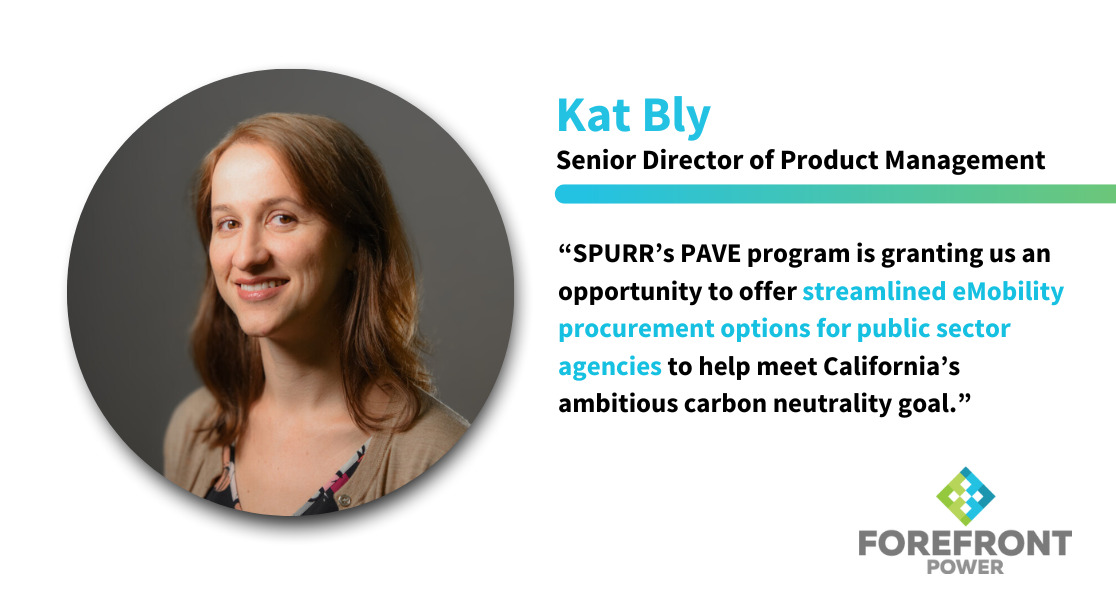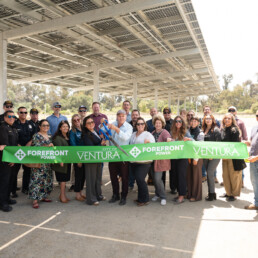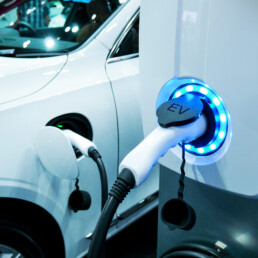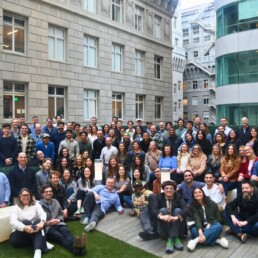Following the announcement of ForeFront Power’s selection for SPURR’s Procurement Assistance for Vehicle Electrification (PAVE) program, we spoke to Senior Director of Product Management Kat Bly to learn more about her vision for ForeFront Power’s eMobility service offering.
Where are you from originally?
KB: I am from Ukraine. I was born and raised there and came to the U.S. to pursue my American dream when I was 21.
What did you want to be when you grew up?
KB: When I was growing up, I never really had a precise idea. You know how some people grow up as children and say they want to be doctors? I never had that, but I always knew that I wanted to do something significant and meaningful. I want to make a contribution towards making our world better. One of the ways to have a positive impact is through climate or clean energy initiatives.That’s what resonated with me and is how I found my way to where I am now.
How did you get into the renewable energy field?
KB: While I was at business school at Pepperdine University, I got a rotational internship at a major utility company in Southern California that gave me an opportunity to work in four completely different business areas. One of those was working on a solar rooftop project during the very beginning of the solar boom in California. This was a project led by Southern California Edison and my role was to work on the planning phases, conducting analysis, and assessing economics. It was exciting to see how renewable energy was a tangible thing and how it was beneficial not just from an environmental perspective, but from a financial perspective. By transitioning to clean energy, you’re not just doing a good thing for the planet, you’re also doing something that makes economic sense.
That was during a time when solar was a cool new technology. Over my career I’ve broadened my focus beyond solar to other clean technologies. We need to think of the energy transition in a holistic way, with all of these technologies working in concert. There isn’t a single, one-size-fits-all solution. Bringing everything together is the key to success here.
How did you find ForeFront Power? When did you join the team?
KB: I joined the ForeFront Power team in 2018. I had worked for Southern California Edison for around seven years. My last role there was managing our fees and managing procurement of renewable energy. Working directly with developers was my first exposure to the development business. I always thought it was so cool that developers were the closest entity to actually seeing these projects materialize. That’s what sparked my interest in development, but it wasn’t until years later that I came back to the field.
After the solar boom, then came the energy storage boom. That was the next big thing, so I got into that field and worked for a battery equipment installer. There I learned that storage is the key to unlocking the full value of solar, and that bringing them together is the optimal solution for the industry and for customers.
When I joined ForeFront Power, my role was to expand our very strong behind-the-meter solar energy business to encompass energy storage, and to find ways to bring them together that made the most economic sense. Since then, ForeFront Power has grown into one of the leading developers of energy storage, pairing storage with solar in California as well as across the United States.
Now in your current role as Senior Director of Product Management, what are your main responsibilities day-to-day?
When I first started as Director of Business Development, I was focused specifically on energy storage, which we expanded into microgrids and backup-capable energy storage. My role has been finding the right partners, evaluating different technologies, and then working with the team to integrate storage into our projects. I got to work on all aspects of the business. I work with the solar team trying to figure out ways to add storage into their existing projects, or how to adjust their sales pitch, or how to find opportunities for their customers to get additional savings and value.
At the beginning of this year my role expanded into Senior Director of Product Management, in which I’m working on EV charging and fleet electrification. Throughout my career I’ve always worked to commercialize new technology, finding a way to make the transition from early-stage pilot projects into something that’s fully commercialized with significant deployments.
That’s what I was doing with storage, and now with eMobility my main responsibilities are the same. I’m staying on top of all the latest technologies, understanding what’s out there, who the major players are, building relationships with those companies, figuring out our strategic partnerships and supplier relationships, and also working on the commercial side with our customers to figure out what exact solution would be best tailored to them. My role is leading that customer-centric process and making sure that we reach as many customers as we can and provide the most value.
How has ForeFront Power’s partnership with SPURR (formerly the School Project for Utility Rate Reduction) helped increase distributed solar generating capacity across California?
KB: Our partnership with SPURR has been absolutely instrumental in behind-the-meter solar energy deployment in the public sector. We’ve reached so many customers and we have been able to help so many school districts, universities, and other public entities. This is a really great program that allows these public entities to spend less time and resources running competitive procurement processes, and more time on the things that they do best.
The success we’ve had with SPURR speaks for itself. Our customers share positive feedback that they’re very pleased to not only have a way to save money on their utility bills, but also to have this new clean energy resource that’s helping the environment by displacing fossil fuel generation of energy and also educating students. Universities use it as a learning opportunity to showcase how pairing complementary technologies like solar and storage is the perfect energy solution. We’re excited to have become the #1 provider of solar/storage solutions for the CA public sector – while there are a lot of providers, not many can meet the needs of public sector agencies.
What does SPURR’s Procurement Assistance for Vehicle Electrification (PAVE) program mean for the California public sector and the state’s climate goals?
KB: Almost every public entity in California has some portion of their fleet that they have the opportunity to electrify. California is #1 auto market in the U.S. with $143B in sales in 2022. 1 of 4 vehicles being sold in the state are now electric. What you see in California often shows up in other locations across the country and the world. Many have fleets and almost all of them have employees or staff or students who use their parking facilities. As more and more people electrify their vehicles, there is a huge opportunity for public electric vehicle charging infrastructure.
ForeFront is thrilled to have been selected for the PAVE program. It’s an honor and it means that we can now provide a more holistic solution to our customers. When we approach a customer, we not only give them a source of energy to electrify their building, but we also have the ability to advise them and help them create the plan to electrify. We can work together with our customers on a long-term basis as their advisor and solution provider to help them implement the project from start to finish. After previously winning SPURR’s solar and storage program, the amount of success we’ve had and the amount of customers we were able to assist was unprecedented. SPURR’s PAVE program is now granting us a similar opportunity to be able to offer streamlined eMobility procurement options to public sector agencies to be able to meet California’s ambitious carbon neutrality goal.
Could we explore further the benefits that public agencies can reap from fleet electrification?
KB: One of the key benefits is fuel savings. If you have a conventional fleet, you’re beholden to the cost of gasoline in operating the fleet. Every school bus is a cost to these customers; the savings from switching to EVs vary from project to project, and our role is to help them maximize those savings.
There are also numerous public funding opportunities such as grants, incentive and rebate programs that allow you to subsidize the portion of your electrical infrastructure. In some cases, the entire infrastructure costs can be paid for by these subsidies. Some programs, like the U.S. EPA’s Clean School Bus Program, cover nearly the entire cost of your new electric school buses. But then there are other subsidies that provide some fixed benefit by type of vehicle. Navigating those is at this point very complex, so that’s something we can help our customers with. Everyone is different and every situation requires specific scrutiny to understand who’s eligible and how to structure your application to be successful.
Then there is the benefit of fossil fuel reduction and contributing to this clean energy transition, and your community and your stakeholders knowing that you’ve added solar, energy storage, and are now electrifying your bus fleet. Many school districts and public agencies with fleets are actively thinking of fleet electrification plans. We know these customers just need to determine the best way to implement it.
Lastly, there is the educational component and the fact that students are going to be driven to school in a clean vehicle. That helps with overall societal benefits, health benefits, driver retention, and job satisfaction.
How does ForeFront Power plan to continue expanding its service offerings and grow into new markets?
KB: ForeFront Power doesn’t just help public agencies in California. We have a footprint across the U.S. and Mexico, and we help private sector companies tackle fleet electrification and eMobility as well. We’ve had several examples of this throughout the years, including experience on Rivian’s solar charging yard at their manufacturing facility in Normal, Illinois where they power Amazon’s delivery vehicles with clean power from the sun.
Opportunities for valuable clean electrification are growing by the month. Incentives like the IRA which provides rebates for the purchase of electric vehicles, SPURR’s programs in California, tax incentive adders for domestic manufacturing plants are a great means for this to happen. This is an inflection point in the transportation industry’s pivot to being powered by clean electricity, and we’re excited to be on the forefront of this movement.
What do you envision for the future of the energy industry and what is ForeFront Power’s role in building that future?
KB: We believe in a holistic energy approach where it’s not just one technology solution, but a combination of them – on-site solar, energy-efficiency, demand response, electrified fleets, electric vehicle charging stations, an electrified fleet and other technologies. The future is combining many of these solutions together and more importantly, deploying them in a way that maximizes the overall benefits to the customer. That’s exactly our strategy at ForeFront Power – to offer a holistic view that puts the customer first. We approach development from their angle to understand the best possible solution mix for them.
Interested in learning more?
We would love to discuss how our solutions might be a fit for your organization. Contact one of our solar, storage, or e-mobility experts today:








